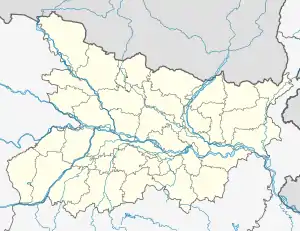| Ajgaibinath Temple | |
|---|---|
 | |
| Religion | |
| Affiliation | Hinduism |
| District | Bhagalpur district |
| Deity | Ajgaibinath (Shiva) |
| Festivals | Maha Shivratri |
| Governing body | Ajgaibinath Mandir Committee |
| Location | |
| Location | Sultanganj, Bhagalpur |
| State | Bihar |
| Country | India |
 Location in Bihar | |
| Geographic coordinates | 25°15′08.6″N 86°44′03.5″E / 25.252389°N 86.734306°E |
| Architecture | |
| Type | Vedic-Style |
| Part of a series on |
| Hinduism |
|---|
 |
The Ajgaibinath Temple or Ajgaivinath Dham is a famous Hindu temple located in Sultanganj, Bhagalpur district, Bihar, India. It is a significant pilgrimage site for Hindus and holds great religious importance. It is situated on the bank of holy river Ganga.It lies in the Anga region of Bihar.
Religious significance
Ajgaibinath Temple is also known as Mankamna Temple. Devotees say that wishes made at this place are fulfilled. In this regard, according to Mahant Premanand ji of this temple, "There is such a belief of this place that the official worship of this place is done first. Only after this the Mahadev of Devghar is worshipped.[1]
Mahants
- Mahant Siddhanath – 1st Mahant
- Mahant Kedarnath – 2nd
- Mahant Premanand Giri – present
Deity and belief
The main deity worshipped in the Ajgaibinath Temple is Lord Shiva, who is also known as Ajgaibinath. According to Hindu mythology, it is believed that Lord Shiva resided here for some time during his journey to the Amarnath Cave. The temple's historical and religious significance attracts a large number of devotees throughout the year, especially during special occasions and festivals dedicated to Lord Shiva.[5]
Shravani Mela and Kanwar Yatra
Millions of pilgrims visit this shrine every year. It is famous for the mela of Shraavana (a month of the Hindu calendar), between July and August. About 8 to 10 million devotees visit the place from various parts of India and offer holy water of Ganges (Uttarvahini Ganga) to the deity collected from Sultanganj at the bank of the Ajgaibinath Temple and offer their prayers to Ajgaibinath (Lord Shiva) which is almost 108 km from Deoghar and Baidyanath. The water is also brought by the Kānvarias, who carry the water in Kavadi, and walk all the distance, on barefoot. You will find large crowds walking all the way carrying water. An unbroken line of people in saffron-dyed clothes stretches over the full 108 km for the month. The pilgrims are called Dak Bam and they do not stop even once in their journey from Ajgaibinath , Sultangunj, located at Bhagalpur district to Vaidyanath . Pilgrims to the temple later visit the Basukinath temple.[6][7][8]
Gallery


See also
References
- ↑ "Sawan 2023 : भगवान से रूठे भक्त; देवघर के लिए जहां से जल लेते हैं, भोले के उस अजगैबीनाथ मंदिर में वीरानी क्यों". Amar Ujala (in Hindi). Retrieved 22 July 2023.
- ↑ "Mahant Premanand Giri-Mahants History of Ajgaivinath".
- ↑ "Walking with Pilgrims: The Kanwar Pilgrimage of Bihar, Jharkhand and the Terai of Nepal [1 ed.] 1000732509, 9781000732504". dokumen.pub. Retrieved 28 July 2023.
- ↑ "अजगवीनाथ मंदिर यहां के जल से होता है देवघर में बाबा बैद्यनाथ का जलाभिषेक रोचक है महंत-शिव दर्शन की कहानी - Sawan 2023 devotees take Jal from Ajgaivinath Temple Sultanganj Bhagalpur for Deoghar". Jagran (in Hindi). Retrieved 28 July 2023.
- ↑ Tourism, Bihar (30 January 2023). "Ajgaibinath Temple". tourism.bihar.gov.in. Retrieved 20 July 2023.
- ↑ "Administration gears up for Shravani Fair - Times Of India". 11 August 2011. Archived from the original on 11 August 2011. Retrieved 22 July 2023.
- ↑ "Month-long Shrawani Mela ends - Times Of India". 11 August 2011. Archived from the original on 11 August 2011. Retrieved 22 July 2023.
- ↑ "PHOTOS: अजगैबीनाथ मंदिर में सरकारी पूजा की देखें तस्वीर, सोमवार को सुल्तानगंज में कांवरियों का दिखा हुजूम". Prabhat Khabar (in Hindi). 17 July 2023. Retrieved 22 July 2023.